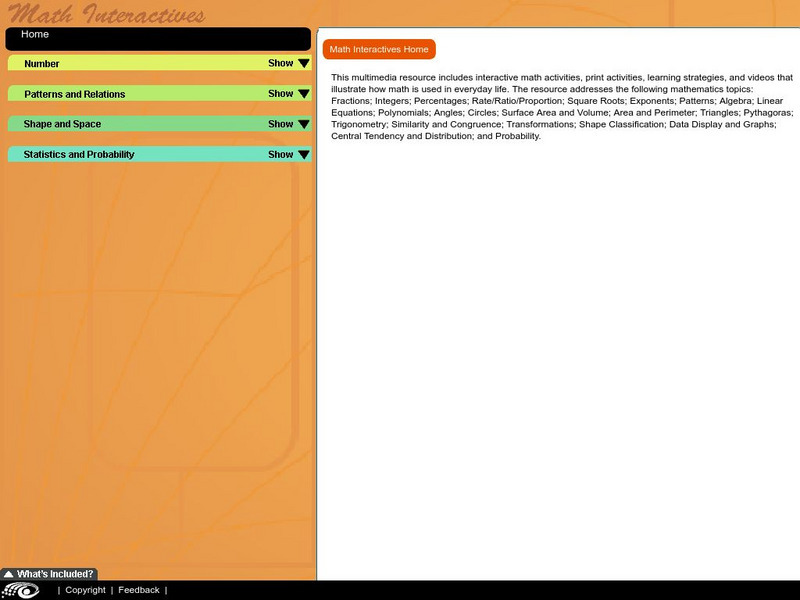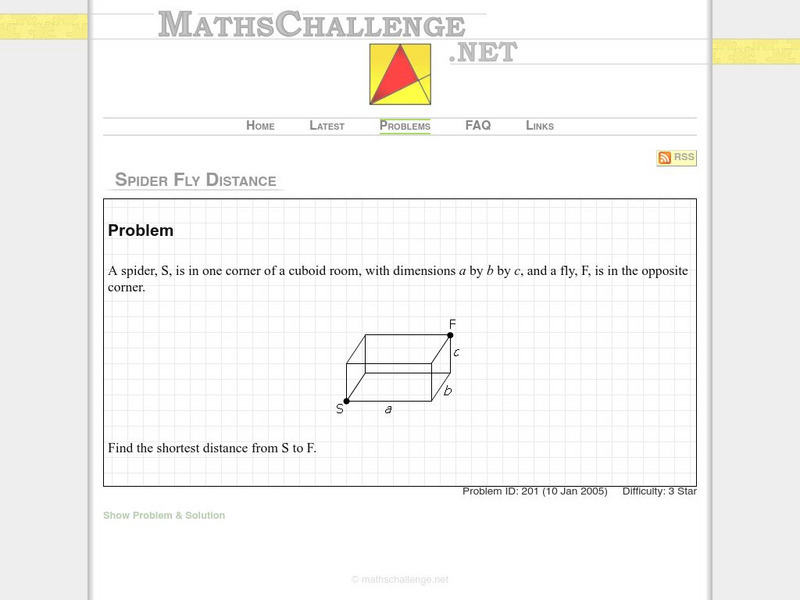Curated OER
Getting Familiar with Fractals
Students use the Internet to answer lab questions about fractals, and then construct fractals using the initial stage and iteration rule. They complete tables and generate rules for the "nth" term and create their own fractals.
Curated OER
Connecting Measurement
Students participate in activities the connect measurement to geometry, statistics, estimation, and the real world. They collect measurements from their elbow to the tip of their middle finger and make a box plot of the data as well as...
Curated OER
Polyhedra
Seventh graders explore the characteristics of three-dimensional figures. They compare the nets of figures. Students describe the relationship between the nets draw and the solid. They identify the vertices, edges and faces of the...
Curated OER
Surface Area of Prisms
Students calculate the surface area of different prisms. In this geometry lesson, students identify the shapes of solids based on the properties of that solid. They calculate the surface area using nets and properties of prisms.
Curated OER
Volume of a Stair-Step
Sixth graders calculate the volume of a stair-step. In this volume lesson, 6th graders apply their knowledge of the formula for finding volume. They practice their use of math language since this lesson is presented in a Japanese...
Curated OER
Classifying Pyramids
Students study pyramids. In this prisms lesson, students explore the attributes of pyramids. Students will explore the lateral surface area of pyramids and be able to distinguish pyramids from other space shapes.
Curated OER
Shapes are Everywhere
Second graders gain an understanding of geometric shapes and spatial reasoning. They learn the attributes of solid shapes in everyday activities. Students compare geometric shapes to everday objects, finding things that serve a purpose...
Curated OER
San Diego Architecture
Eighth graders study the cultural and architectural history of San Diego. After study they create a design of a home based of features from historical and modern homes found in their research.
Florida Center for Instructional Technology
Two for One Box Company
Given a box of certain dimensions, young mathematicians must determine if a box that is twice as big, actually holds twice as much. This is a brain-teaser of a problem. The worksheet provides a handy table that has learners calculate the...
Government of Alberta
Learn Alberta: Math Interactives: Exploring Surface Area, Volume, and Nets
Investigate the concepts of area, volume, 3D shapes, and nets using this interactive Learn Alberta math. The solid shapes focused on this exploration include rectangular and triangular prisms, rectangular and triangular pyramids,...
CK-12 Foundation
Ck 12: Geometry: Cross Sections and Nets
[Free Registration/Login may be required to access all resource tools.] In this lesson students draw two-dimensional representations of solid figures. Students examine guided notes, review guided practice, watch instructional videos and...
CK-12 Foundation
Ck 12: Geometry: Cross Sections and Nets
[Free Registration/Login may be required to access all resource tools.] This concept teaches students two ways to represent three dimensions in two dimensions: cross-sections and nets. Students examine guided notes, review guided...
CK-12 Foundation
Ck 12: Interactive Geometry: 1.11 Surface Area and Nets
Explore surface areas and nets with 2D and 3D shapes.
CK-12 Foundation
Ck 12: Geometry: Cross Sections and Nets
[Free Registration/Login may be required to access all resource tools.] In this lesson students draw two-dimensional representations of solid figures. Students examine guided notes, review guided practice, watch instructional videos and...
Texas Education Agency
Texas Gateway: Drawing Conclusions About Three Dimensional Figures From Nets
Given a net for a three-dimensional figure, the student will make conjectures and draw conclusions about the three-dimensional figure formed by the given net.
CK-12 Foundation
Ck 12: Cross Sections and Nets: Cereal Box Grid
[Free Registration/Login Required] Students will explore cross sections and nets of three dimensional objects. Click challenge me to answer practice questions and click learn more to watch a video.
Texas Education Agency
Texas Gateway: Finding Lateral and Total Surface Area
Given concrete models and nets (2-dimensional models) of prisms, pyramids, and cylinders, the student will find and determine the lateral and total surface area.
CK-12 Foundation
Ck 12: Geometry: Representing Solids Study Guide
[Free Registration/Login may be required to access all resource tools.] This study guide gives an overview of isometric view, orthographic view, cross-section, and nets.
ClassFlow
Class Flow: 3 D Objects and Nets
[Free Registration/Login Required] This is a review of solid figures, nets, and counting faces, nets and vertices in 3 dimensional figures. There is a 5 question Activote session at the end of the flipchart.
Alabama Learning Exchange
Alex: Nifty Nets
During this activity, students will create nets for prisms. They will find the volume and surface area of the shapes. They will also use interactive activities to review three-dimensional shapes.This lesson plan was created as a result...
Texas Education Agency
Texas Gateway: Creating Nets for Three Dimensional Figures
Given nets for three-dimensional figures, the student will apply the formulas for the total and lateral surface area of three-dimensional figures to solve problems using appropriate units of measure.
Maths Challenge
Maths challenge.net: Spider Fly Distance
A "three star geometry problem" requiring knowledge of how to complete geometric proofs and some prior math skills to figure the shortest distance between the opposite corners of a cuboid.
Khan Academy
Khan Academy: Nets of Polyhedra
Practice matching 2D nets to the 3D shapes the fold up into. Students receive immediate feedback and have the opportunity to try questions repeatedly, watch a video or receive hints.
Khan Academy
Khan Academy: Surface Area Using Nets
In this exercise, students practice finding the surface area using nets. Students receive immediate feedback and have the opportunity to get hints and try questions repeatedly.






















